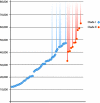Intraspecific phylogenetic analysis of Siberian woolly mammoths using complete mitochondrial genomes
- PMID: 18541911
- PMCID: PMC2423413
- DOI: 10.1073/pnas.0802315105
Intraspecific phylogenetic analysis of Siberian woolly mammoths using complete mitochondrial genomes
Abstract
We report five new complete mitochondrial DNA (mtDNA) genomes of Siberian woolly mammoth (Mammuthus primigenius), sequenced with up to 73-fold coverage from DNA extracted from hair shaft material. Three of the sequences present the first complete mtDNA genomes of mammoth clade II. Analysis of these and 13 recently published mtDNA genomes demonstrates the existence of two apparently sympatric mtDNA clades that exhibit high interclade divergence. The analytical power afforded by the analysis of the complete mtDNA genomes reveals a surprisingly ancient coalescence age of the two clades, approximately 1-2 million years, depending on the calibration technique. Furthermore, statistical analysis of the temporal distribution of the (14)C ages of these and previously identified members of the two mammoth clades suggests that clade II went extinct before clade I. Modeling of protein structures failed to indicate any important functional difference between genomes belonging to the two clades, suggesting that the loss of clade II more likely is due to genetic drift than a selective sweep.
Conflict of interest statement
The authors declare no conflict of interest.
Figures




References
-
- Barnes I, et al. Genetic structure and extinction of the woolly mammoth, Mammuthus primigenius. Curr Biol. 2007;17:1072–1075. - PubMed
-
- Ho SYW, Heupink TH, Rambaut A, Shapiro B. Bayesian estimation of sequence damage in ancient DNA. Mol Biol Evol. 2007;24:1416–1422. - PubMed
-
- Gilbert MTP, et al. Whole-Genome shotgun sequencing of mitochondria from ancient hair shafts. Science. 2007;317:1927–1930. - PubMed
-
- Krause J, et al. Multiplex amplification of the mammoth mitochondrial genome and the evolution of Elephantidae. Nature. 2006;439:724–727. - PubMed
Publication types
MeSH terms
Substances
Grants and funding
LinkOut - more resources
Full Text Sources

